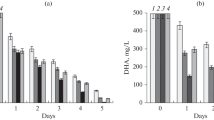Abstract
The ability of a Rhodococcusaetherovorans strain, BCP1, to grow on butane and to degrade chloroform in the 0–633 μM range (0–75.5 mg l−1) via aerobic cometabolism was investigated by means of resting-cell assays. BCP1 degraded chloroform with a complete mineralization of the organic Cl. The resulting butane and chloroform maximum specific degradation rates were equal to 118 and 22 μmol \({{mg}}^{{{{ - 1}}}}_{{{{protein}}}} {{day}}^{{{{ - 1}}}}\), respectively. Butane inhibition on chloroform degradation was satisfactorily interpreted by means of a model of competitive inhibition, with an inhibition constant equal to 38 % of the estimated butane half-saturation constant, whereas chloroform (at 11 μM) did not inhibit butane utilization. Acetylene (1,720 μM) induced an almost complete inactivation of the degradation of both butane and chloroform, indicating that the studied cometabolic process is mediated by a monooxygenase enzyme. BCP1 proved capable of degrading vinyl chloride and 1,1,2-trichloroethane, but not 1,2-trans-dichloroethylene. BCP1 could grow on the intermediates of the most common butane metabolic pathways and on the aliphatic hydrocarbons from ethane to n-heptane. After growth on n-hexane, it was able to deplete chloroform (13 μM) with a degradation rate higher than that obtained, at the same chloroform concentration, after growth on butane.


Similar content being viewed by others
References
Alvarez-Cohen L, McCarty PL (1991) Product toxicity and competitive inhibition modeling of chloroform and trichloroethylene transformation by methanotrophic resting cells. Appl Environ Microbiol 57:1031–1037
Alvarez-Cohen L, Speitel GE Jr (2001) Kinetics of aerobic cometabolism of chlorinated solvents. Biodegradation 12:105–126
Arp DJ, Yeager CM, Hyman MR (2001) Molecular and cellular fundamentals of aerobic cometabolism of trichloroethylene. Biodegradation 12:81–103
Aziz CE, Georgiou G, Speitel GE Jr (1999) Cometabolism of chlorinated solvents and binary chlorinated solvent mixtures using M. trichosporium OB3b PP358. Biotechnol Bioeng 65:100–107
Chang HL, Alvarez-Cohen L (1995) Model for the cometabolic biodegradation of chlorinated organics. Environ Sci Technol 29:2357–2367
Chang HL, Alvarez-Cohen L (1996) Biodegradation of individual and multiple chlorinated aliphatic hydrocarbons by methane-oxidizing cultures. Appl Environ Microbiol 62:3371–3377
Chang WK, Criddle CS (1997) Experimental evaluation of a model for cometabolism: prediction of simultaneous degradation of trichloroethylene and methane by a methanotrophic mixed culture. Biotechnol Bioeng 54:491–501
Ely RL, Williamson KJ, Arp DJ (1997) Cometabolism of chlorinated solvents by nitrifying bacteria: kinetics, substrate interactions, toxicity effects and bacterial response. Biotech Bioeng 54:520–534
Frascari D, Kim Y, Dolan ME, Semprini L (2003) A kinetic study of aerobic propane uptake and cometabolic degradation of chloroform, cis-dichloroethylene and trichloroethylene in microcosms with groundwater/aquifer solids. Water, Air, and Soil Pollution: Focus 3:285–298
Frascari D, Zannoni A, Fedi S, Pii Y, Zannoni D, Pinelli D, Nocentini M (2005) Aerobic cometabolism of chloroform by butane-grown microorganisms: long-term monitoring of depletion rates and isolation of a high-performing strain. Biodegradation 16: 147–158
Hamamura N, Page C, Long T, Semprini L, Arp DJ (1997) Chloroform cometabolism by butane-grown CF8, Pseudomonas butanovora and Mycobacterium vaccae job5 and methane-grown Methylosinus trichosporium OB3b. Appl Environ Microbiol 63:3607–3613
Kim Y, Semprini L, Arp DJ (1997) Aerobic cometabolism of chloroform and 1,1,1-trichloroethane by butane-grown microorganisms. Bioremediation J 1:135–148
Kim Y, Arp DJ, Semprini L (2000) Chlorinated solvent cometabolism by butane-grown mixed culture. J Environ Eng 126:934–942
Kim Y, Arp DJ, Semprini L (2002) Kinetic and inhibition studies for the aerobic cometabolism of 1,1,1-trichloroethane, 1,1-dichloroethylene, and 1,1-dichloroethane by a butane-grown mixed culture. Biotechnol Bioeng 80:498–508
Malachowsky KJ, Phelps TJ, Teboli AB, Minnikin DE, White DC (1994) Aerobic mineralization of trichloroethylene, vinyl chloride and aromatic compounds by Rhodococcus species. Appl Environ Microbiol 60:542–548
McClay K, Fox BG, Steffan RJ (1996) Chloroform mineralization by toluene-oxidizing bacteria. Appl Environ Microbiol 62:2716–2722
Oldenhuis R, Vink RLG, Janssen DB, Witholt B (1989) Degradation of chlorinated aliphatic hydrocarbon by Methylosinus trichosporium OB3b expressing soluble methane monooxygenase. Appl Environ Microbiol 55:2819–2826
Oldenhuis R, Oedzes JY, van der Waarde JJ, Janssen DB (1991) Kinetics of chlorinated hydrocarbon degradation by Methylosinus trichosporium OB3b and toxicity of trichloroethylene. Appl Environ Microbiol 57:7–14
Peterson GL (1977) A simplification of the protein assay method of Lowry et al. which is more generally applicable. Anal Biochem 83:346–356
Shanklin J, Whittle E (2003) Evidence linking the Pseudomonas oleovorans alkane omega-hydroxylase, an integral membrane diiron enzyme, and the fatty acid desaturase family. FEBS Lett 545:188–192
Sluis MK, Sayavedra-Soto LA, Arp DJ (2002) Molecular analysis of the soluble butane monooxygenase from Pseudomonas butanovora. Microbiology 148:3617–3629
Smith LH, Kitanidis PK, McCarty PL (1997) Numerical modeling and uncertainties in rate coefficients for methane utilization and TCE cometabolism by a methane-oxidizing mixed culture. Biotechnol Bioeng 53:320–331
Strand SE, Bjelland MD, Stensel HD (1990) Kinetics of chlorinated hydrocarbon degradation by suspended cultures of methane-oxidizing bacteria. Res J Water Pollut Control Fed 62:124–129
Author information
Authors and Affiliations
Corresponding author
Rights and permissions
About this article
Cite this article
Frascari, D., Pinelli, D., Nocentini, M. et al. Chloroform degradation by butane-grown cells of Rhodococcus aetherovorans BCP1. Appl Microbiol Biotechnol 73, 421–428 (2006). https://doi.org/10.1007/s00253-006-0433-3
Received:
Revised:
Accepted:
Published:
Issue Date:
DOI: https://doi.org/10.1007/s00253-006-0433-3




